Text
Creative output explanation and calculations
Creative manifestation
I chose to use disposable razors as an example of needless waste as a creative output for my manifesto. I chose to use razors as they are completely un-recyclable^ and can be replaced by a built-to-last alternative (safety razor) which, with care, can last a lifetime.
I chose the layout and materials choice in my creative manifestation to be as visually striking as possible and to give the audience a very real and quantifiable sense of how much waste small, disposable everyday items produce in their manufacturing.
I compared the disposable razors with a reusable safety razor to further highlight the needlessness of disposable, environmentally harmful products which also contribute towards consumerism and a throwaway society by devaluing the user’s sense of worth for any particular product. The material qualities and build finish of the reusable razor highlights the attachment and sentimentality towards the object in comparison to the disposable razors. The attachment towards an object goes against the ideas of consumerism by putting more sentimental value on a product which makes the user less likely to buy new products because they have developed an attachment to the one they already have.
^ http://www.earth911.com/living-well-being/health/can-you-recycle-disposable-razors/
^ http://greenopedia.com/recycle-razor-blades/
Promotional material
My promotional material is needlessly packaged cards which simply have the title of my manifesto “Make Less, But Better” spread across the two sides. The cards are blister packed, bubble wrapped, taped and then presented in a cardboard postage box with yet more bubble wrap to highlight the needless use of packaging which is utilised by many products. They are designed to supplement my critique on disposable products by being a critique on the packaging used by them. They are designed to be difficult to open while also having some mystery to them, as the user cannot see the card until the blister pack is opened. My goal with these is to create a memorable experience for the user by having them interact with the promotional material which should make them remember my manifesto, creative output and message I am sharing. The simple “Make Less, But Better” is meant to be easy to remember for the user while also being ironic in comparison to the packaging of the phrase as it is totally unnecessary and goes against my manifesto’s message.
Calculations for creative output:
OIL
60 razors = 300g polypropylene (PP) = 525g raw oil to produce (1kg PP uses 1.75kg oil to produce)
source: http://www.designinsite.dk/htmsider/inspmat.htm
525g oil = 640mL volume (1kg oil = 1200mL)
source: http://www.onlineconversion.com/forum/forum_1124894780.htm
C02
300g plastic produces 1.8kg of C02 (including incineration) or 0.9kg C02 during production
source: http://timeforchange.org/plastic-bags-and-plastic-bottles-CO2-emissions
0.9kg C02 occupies 0.5m3
source: http://www.umsl.edu/~biofuels/Energy%20Meter%20labs/How%20much%20volume%20does%20a%20kg%20of%20CO2%20occupy.pdf
0.5m3 = 30 standard balloons (assuming each balloon is 15cm in radius (V = 4/3*pi*r3) = 0.015m3 per balloon (0.5m3/0.015=33.33) rounded to reflect neck of balloon increasing volume)
OUTPUT
60 razors
640mL oil
0.5m3 C02 represented by 30 balloons
0 notes
Photo
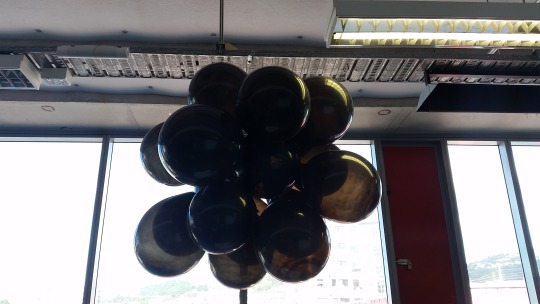
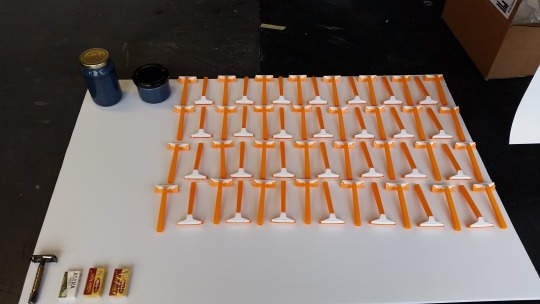
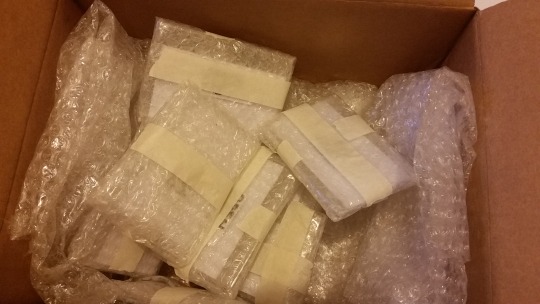
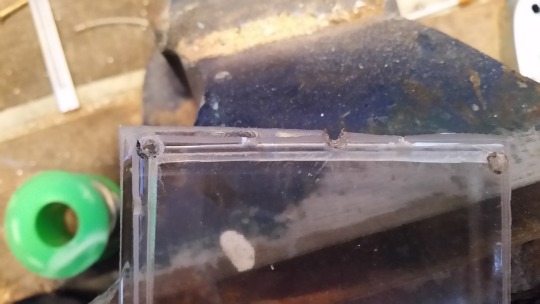
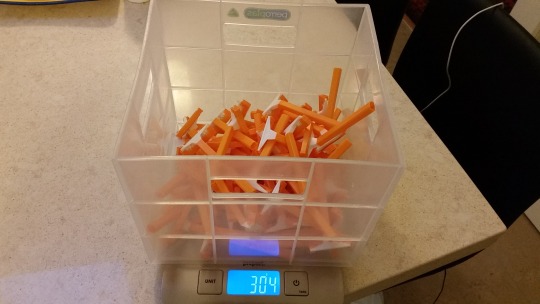
Creative manifestation outputs, highlighting C02 produced, oil used, disposable razors compared to the equivalent reusable razor, promotional material and a couple of quick development shots
0 notes
Photo
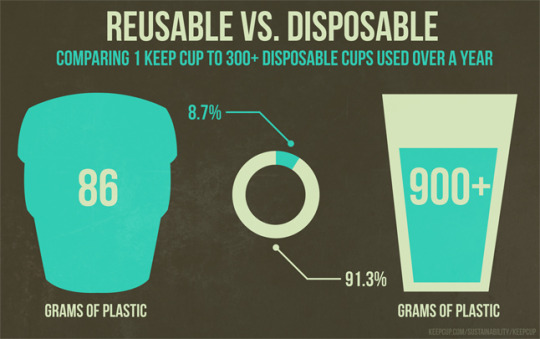
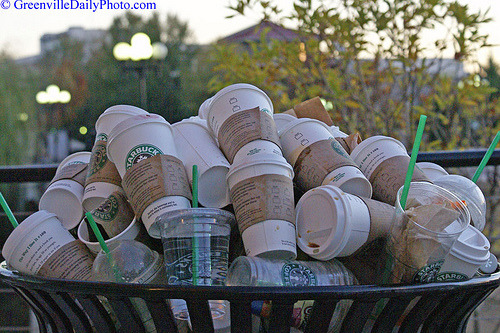
Creative manifesto inspiration - outlining the waste caused by disposable or one-use products.
I intend to showcase this at the exhibition in a physical way to have greater and more tangible impact with the audience
0 notes
Text
Make Less, But Better
Final Manifesto
We, as humans, as society, need less shit. We produce unnecessarily large amount of useless, wasteful, and ill-informed products which contributes to consumerism - now a fundamental aspect of modern society - the devaluation of personal possessions, and the pollution of the environment and needless consumption of resources (Stearns, 2012).
Products can be put on a spectrum ranging from cherished, sentimental, and precious items down to well designed, valued and looked after items, utilitarian products which fulfil their job and nothing more, and finally useless tat, trash, and waste which is intended to be disposed of after its initial use only to spend the rest of its life in a landfill while the consumer keeps on consuming and disposing endlessly.
This final category of products needs to be eliminated. It is of no use. It devalues personal possessions, encourages consumerism, and harms the environment. People have come to accept the ability to dispose of their undesirable items and have them disappear forever as a right (Bozak, 2012). These products were designed to be used, but never to be disposed of in a world which could never decompose such an object. The cost to the environment of many of these products, still today, is not a dominant issue (Smith, 1998).
Humanity needs to look to the past and re-adopt the “built to last” philosophy. Not only were many older products built to last, but they were also built simply enough to be repaired, often by the owner, and these objects today are some of which we cherish the most – not just because they’re old, but because they’re solid. Reliable, dependable, honest, and not frivolous. This connection to objects, on an emotional level, needs to be strived for in design. Creating objects which people value and cherish encourages a society which takes care of its possessions, a society which won’t throw away a perfectly good product save for one fixable defect. A society which has less, but better.
Bibliography
Bozak, N. (2012). Lights, Camera, Natural Resources. In N. Bozak, The Cinematic Footprint (pp. 155-188). New Brunswik: Rutgers University Press.
Smith, T. N. (1998). Tending Our Goats at the Edge of Apocalypse. In T. N. Smith, The Myth of Green Marketing (pp. 65-87). Toronto: University of Toronto Press.
Stearns, P. N. (2012). Dilemmas of Progrss in Modern Society. In P. N. Stearns, Satisfaction Not Guarenteed (pp. 213-253). New York: NYU Press.
0 notes
Text
Manifesto - second draft “Make Less Stuff, But Better”
A re-focussed manifesto, concentrating on one aspect of my original draft
Make less stuff, but better
We, as humans, as society, need less shit. We produce unnecessarily large amount of useless, wasteful, and ill-informed products which contributes to consumerism, the devaluation of personal possessions, and the pollution of the environment and needless consumption of resources.
Products can be put on a spectrum ranging from cherished, sentimental, and precious items down to well designed, valued and looked after items, utilitarian products which fulfil their job and nothing more, and finally useless tat, trash, and waste which is intended to be disposed of after its initial use only to spend the rest of its life in a landfill while the consumer keeps on consuming and disposing endlessly.
This final category of products needs to be eliminated. It is of no use. It devalues personal possessions, encourages consumerism, and harms the environment, all because the product is intended to be disposed of in a world, in nature, which could never decompose such an object.
Humanity needs to look to the past and re-adopt the “built to last” philosophy. Not only were many older products built to last, but they were also built simply enough to be repaired, often by the owner, and these objects today are some of which we cherish the most – not just because they’re old, but because they’re solid. Reliable, dependable, honest, and not frivolous. This connection to objects, on an emotional level, needs to be strived for in design. Creating objects which people value and cherish encourages a society which takes care of its possessions, a society which won’t throw away a perfectly good product save for one fixable defect. A society which has less, but better.
1 note
·
View note
Photo
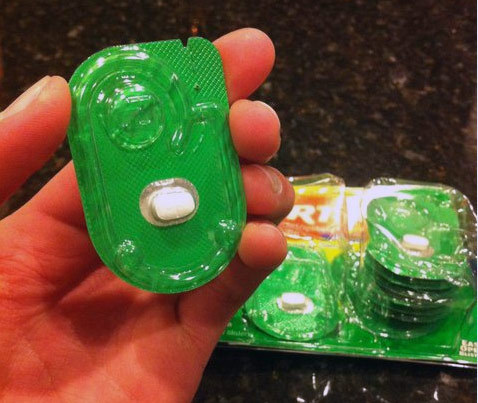
Idea for the creative output for my manifesto in the form of extremely over-packaged promotional material to highlight wastage, excess, and unnecessary production in product design and manufacture
0 notes
Text
CCDN331
The Case for Useful Design
It is not enough for a design simply to look good. This is a widely accepted view which I indeed support. Design must serve its function in the most effective, simple, and understandable manner too. But, even if a design fulfils these criteria, it still is not enough. A design must have a purpose, as well as a function. The purpose in the design lies not only in its intended function, but also in its innovation value. Designers must ask themselves what their design is contributing to the world, not just tangibly, but also emotionally, culturally, and environmentally. Designers must ask “does the world really need a new…or another…?” when designing a mass-userbase product. True, the world may not need a new guitar design or another necklace, but these are objects which users form bonds to, and not mass-consumed, semi-disposable items of convenience. Pure usefulness does not necessarily make a good design; a good design is made when the design has an emotional impact on the user, something which the user becomes attached to, and which doesn’t simply satisfy a fad.
I believe that products can be placed along a linear progression, from purely functional, semi- or completely throwaway items, like the torch in your glove box or plastic lighter in your pocket, to cherished possessions like your uncle’s Mustang or your vintage Fender Strat. The problem in design lies in these low-end products, and in the consumer-driven first world which treats these objects with little to no value. These objects not only encourage consumerism by devaluing their own worth and thereby the value people place on their possessions, but also, and more importantly, having a massive impact on the environment. When an object becomes so worthless that it is better to throw it away than donate or sell it, the design has failed. A good design must consider the end of the lifecycle of the product. If a product is designed to be disposed of, like a Bic lighter or pen, then the designer and producer must consider the object impact on the environment when it is inevitably disposed of, and at the moment the vast majority of products do not consider this, which is reflected in the material choices and degradability of materials employed in most of these low-end designs.
The technology to mass produce items has far surpassed the technology of bio- and environmentally friendly products. Products produced when the world’s manufacturing technologies were more primitive have had a much lower impact on the environment in terms of littering than products today (hazardous chemicals employed frequently in the past aside). These products were built to last, with sturdy materials and an intrinsic value to the products which meant they were not thrown away so wantonly as today.
0 notes
Text
Machine and Human Hand
My submission for project 3 of CCDN331 investigating the relationship between craft and manufacturing, with a particular emphasis on 3D printing.
Abstract as follows
Machine and Human Hand
It is without a doubt today that technology, production techniques, and machining processes are developing at an ever-increasing rate. The most obvious case of this is that of 3D printing; which, over the last 5 years especially, has gained a huge amount of media attention as well as many misconceptions and false expectations around it. Because of this media attention, there are many who believe that 3D printing is the be-all and end-all of manufacturing; a wonder-machine which can manufacture anything one desires and sit in your home, doing away with the need to order spare parts or learn how to fix your home, car, or appliances by hand. In adopting this attitude, we are moving even closer to losing the art of handiwork. By people believing that any of their needs can be fulfilled simply by clicking print on a machine, we risk losing what makes hand-craft wonderful; the innovation, imperfection, uniqueness, ingenuity, and personal touch of the maker. It is important then that we focus on how we can manipulate these machines through design, rather than how they can manipulate our designs; by working with the material qualities given by these machines, designers and makers can produce items which stay true to the tools used and have uniqueness and sense of character, just like hand-craft.
This essay will focus on the relationship between hand- and machine-craft today, and how by testing the limits of machines and pushing their capabilities we can create products which have all the complexity, nuance and beautiful material qualities which have come to be associated with hand craft.
Literary sources:
Additive Manufacturing: Going Mainstream
This text outlines the uses, benefits, drawbacks, myths, and future of 3D printing. It analyses the growth of 3D printing in the last few years and future projections for the technology. It also dispels many of the common myths or preconceptions that people have about or around 3D printing while also highlighting its current and future possibilities in design and production. I am using this text to clarify and distinguish between the myths of 3D printing commonly held by the public and the actual real world applications this process has.
Downloading Infringement: Patent Law as a Roadblock to the 3D Printing Revolution
This text highlights how patent law, in particular for “arbitrary three-dimensional objects”, is holding back innovation, accessibility and usability in the world of 3D printing. It also goes over a brief history of 3D printing and exactly what it can achieve. The biggest issue this text tackles is patent-law and the protection around the plans and specifications for physical objects. Theoretically it would be possible for someone to get a product, take it apart and replicate it by hand, but with 3D printing and the ease at which people can share and produce objects, the law around the distribution of patented or protected files becomes much more important – just like the protection that games, movies, books and music have. I am using this text as knowledge behind the issue of patent laws in 3D printing and replication of objects and how this would affect the layman in terms of the comparison between replication through additive manufacturing and replicating through hand craft.
Craft Labour and Creative Industries
This text examines the role and status of craft labour in the creative industries. It highlights the often overlooked importance the ‘crafter’ has in this field of work, who is many times overshadowed by the artist or other “creative” role. The threat to craftspeople is also brought up and how, through craft being seen as subordinate to or less important than artistry, these craftspeoples’ profession is at risk. I am using this text to investigate both the difference between the role of ‘crafter’ and ‘creative’ (e.g. artist) and also how craft is defined and how this relates back to objects which are ‘crafted’ through traditional methods and objects which are manufactured through modern methods such as 3D printing.
Banks, M. (2010). Craft Labour and Creative Industries. International Journal of Cultural Policy, 305-321.
Doherty, D. (2012). Downloading Infringement: Patent Law as a Roadbloack to the 3D Printing Revolution. Harvard Journal of Law and Technology, 353-373.
Wohlers, T., & Caffery, T. (2013, June). Additive Manufacturing: Going Mainstream. Manufacturing Engineering, pp. 67-73.
0 notes
Text
Critical Selfie evaluation
My initial focus was around the idea of the ‘intbetweens’ – leftover areas between ‘designed’ structures (Jahangeer, 2010). I considered Jahangeer’s example of in-between spaces; cracks in the walls, splits in the pavement etc. in which nature had reclaimed these in-betweens. After reading Jahangeer’s observations, I looked for these ‘inbetweens’ but on a much larger scale; thoroughfares, alleyways and empty lots. I wanted to find spaces between the designed buildings frequented by many; spaces which people, like nature, had reclaimed and made their own – through graffiti, mis- or re-appropriation and other activities.
From there I moved to my final theme of “Ignored Spaces” – spaces and areas which people payed little or no mind to, but were not necessarily abandoned or forgotten. This was to broaden the subject matter I could capture, and also to see how ignored places or objects were treated and viewed by the city and its inhabitants, especially with the demand for space and newness in many cities, where ignored spaces go against the grain (Banerjee, 2001). I tried to frame my shots so it was difficult to tell where in Wellington the places were. I also made my shots black and white to play on the ignored, dejected theme and reinforce the mood of the images.
In my experience as a Flâneur I felt that I got quite an intimate look at the city, the purposeful exploration and taking time to observe really gives a good opportunity to experience the city very closely and in a new way.
References
Banerjee, T. (2001). The Future of Public Space: Beyond Invented Streets and Reinvented Places. Journal of the American Planning Association, 17-24.
Jahangeer, D. A. (2010). architecturewithoutwalls. In P. M. Noever, Urban Future Manifestos (pp. 1-3). Ostfildern, Germany: Hatje Cantz.
Sánchez, A. (Composer). (2014). Claustrophobia. [A. Sánchez, Performer] On Birdman Soundtrack. United States. (Audio used in photo essay)
2 notes
·
View notes
Video
The final video submission for Critical Selfie, project 2 of CCDN331
3 notes
·
View notes
Video
Example of the type of style of music I’d like to use for the critical selfie project
https://youtu.be/9noX9J8AjFk
0 notes
Photo
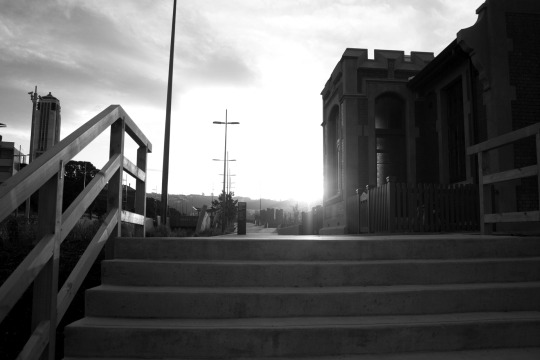
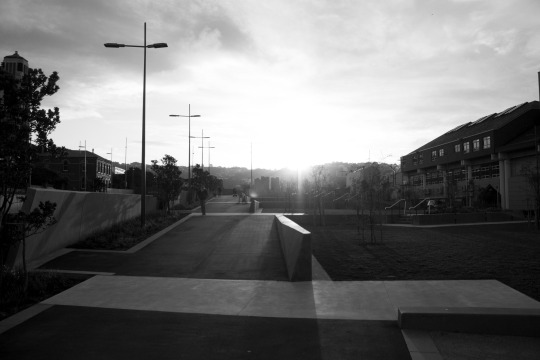

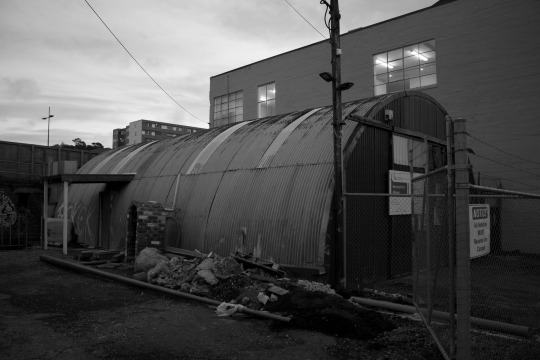


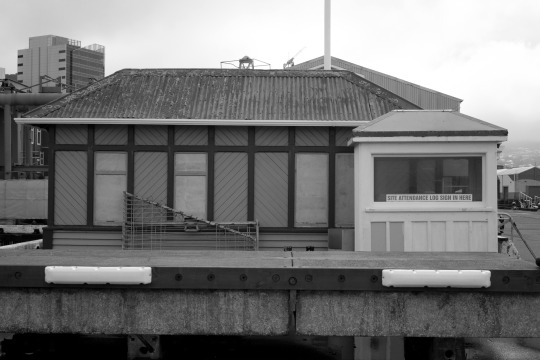
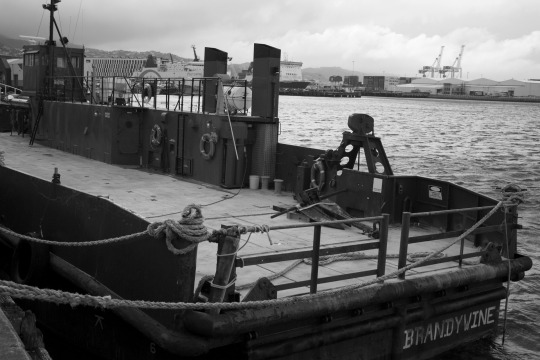

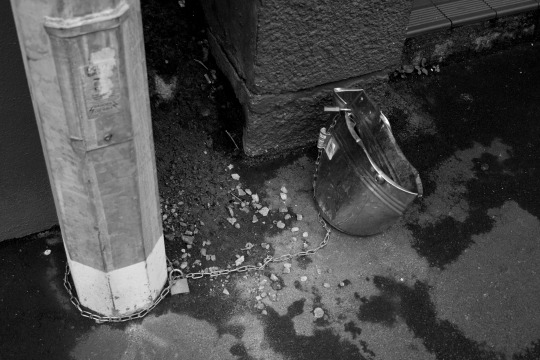
Further iterations, exploring at a smaller scale
0 notes
Photo
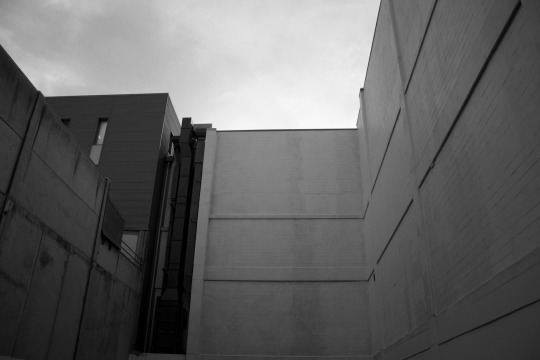
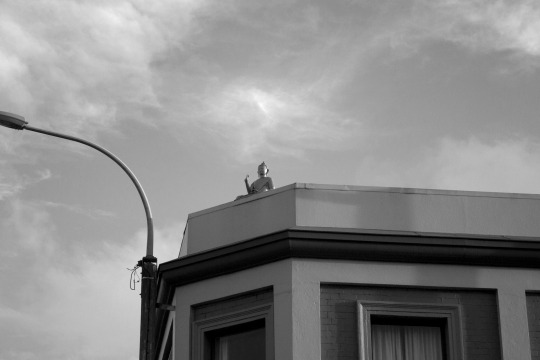

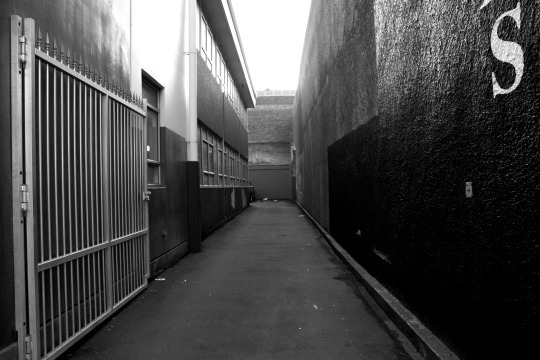
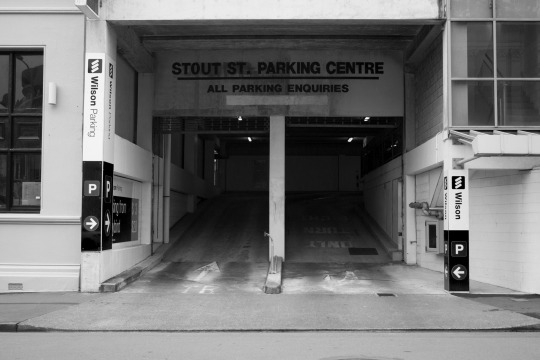

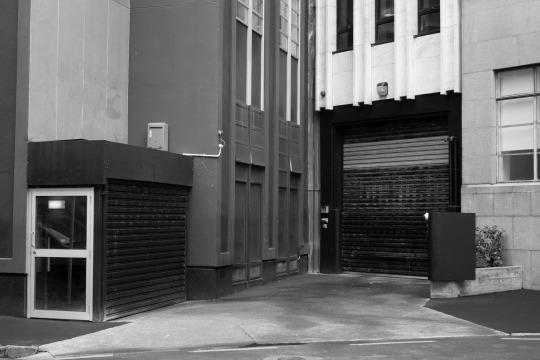
Further iteration of photos exploring transitional spaces focusing on buldings
0 notes
Photo
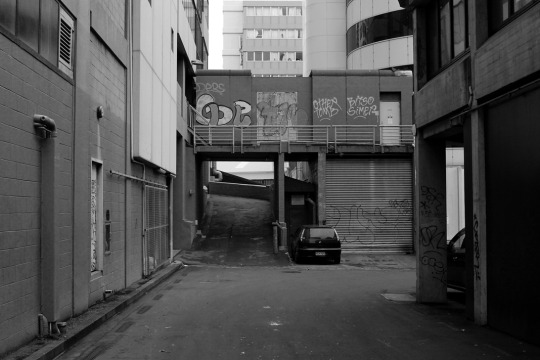
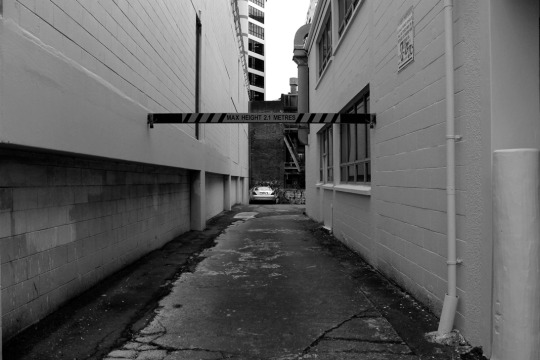


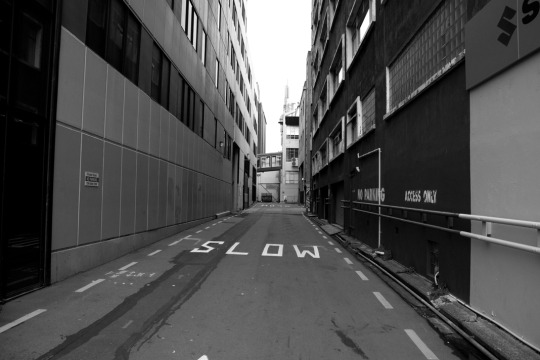
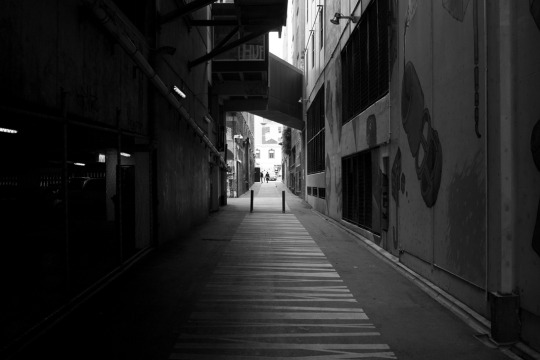

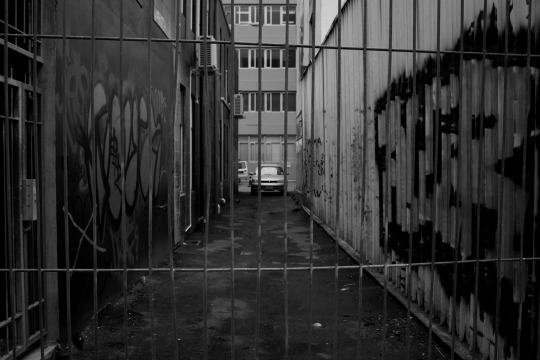
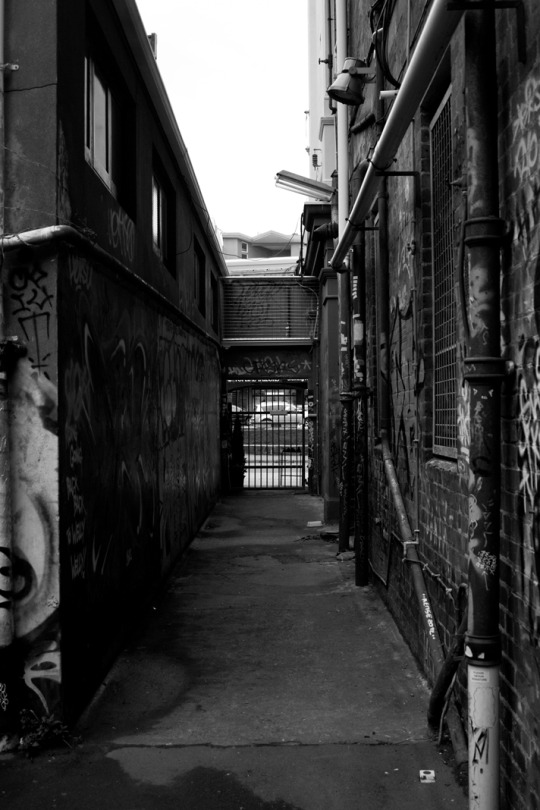
CCDN331 Project 2 - submission 1
I tried to capture transitory places; areas which people passed through but otherwise seldom interacted with and almost never dwelled in. To me, these places are the ‘leftover’ between spaces which have been designed for people – the ‘inbetweens’ (Jahangeer, 2010). These places interested me because their use – aside from thoroughfare – is whatever people make of it. Jahangeer talks of the ‘inbetween’ spaces on a small scale – gaps between walls, footpaths – but I aim to investigate these spaces on a large, human scale, and how people reclaim these voids themselves.
Jahangeer, D. A. (2010). architecturewithoutwalls. In P. M. Noever, Urban Future Manifestos (pp. 1-3). Ostfildern, Germany: Hatje Cantz.
0 notes
Photo
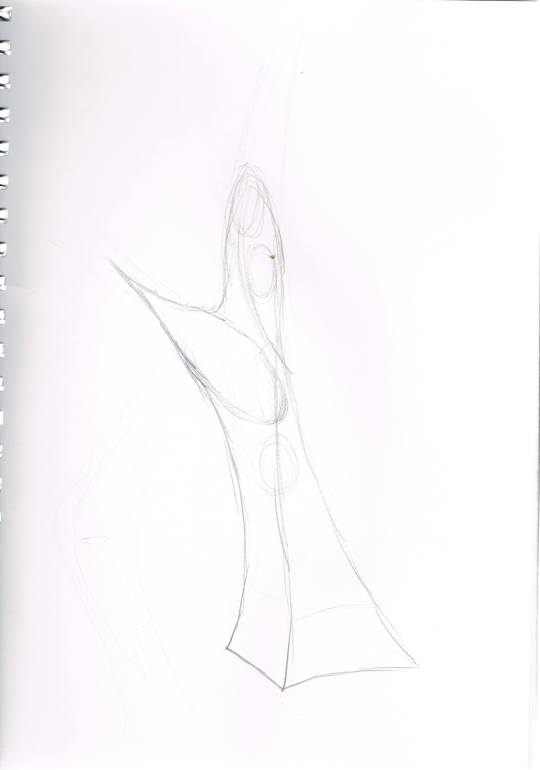
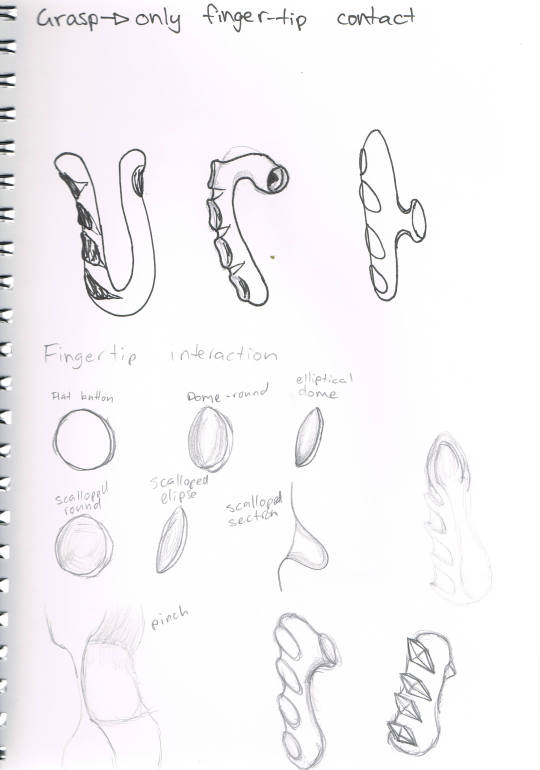

My 3 best investigative sketches for project 3 of DSDN104
0 notes
Photo

My presentation poster for project 3 of DSDN104
0 notes